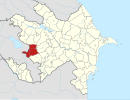Garnakar, Nagorno-Karabakh
Garnakar / Chormanly
Գառնաքար / Çormanlı | |
|---|---|
| Coordinates: 40°02′06″N 46°34′05″E / 40.03500°N 46.56806°E | |
| Country | |
| • District | Kalbajar |
| Elevation | 964 m (3,163 ft) |
| Population (2015)[1] | |
• Total | 161 |
| Time zone | UTC+4 (AZT) |
Garnakar (Armenian: Գառնաքար) or Chormanly (Azerbaijani: Çormanlı) is a village that is located in the Kalbajar District of Azerbaijan, in the region of Nagorno-Karabakh. Until 2023 it was controlled by the breakaway Republic of Artsakh. The village had an ethnic Armenian-majority population[2] until the exodus of the Armenian population of Nagorno-Karabakh following the 2023 Azerbaijani offensive in Nagorno-Karabakh.[3]
History
[edit]During the Soviet period, the village was part of the Mardakert District of the Nagorno-Karabakh Autonomous Oblast.
Historical heritage sites
[edit]Historical heritage sites in and around the village include the 9th-century Hamami Church (Armenian: Համամի եկեղեցի, romanized: Hamami Yekeghetsi), the church of Hangats (Armenian: Հանգած) from between the 11th and 13th centuries, the fortress of Natarin (Armenian: Նատարին) or Ded (Armenian: Դեդ), the church of Mughdusi (Armenian: Մուղդուսի), two villages – one of them named Hamami Dzor (Armenian: Համամի ձոր), a cemetery and khachkars from between the 12th and the 13th centuries, the Mughdusi Cave, and an 18th/19th-century cemetery.[1]
Economy and culture
[edit]The population is mainly engaged in agriculture and animal husbandry. As of 2015, the village has a municipal building, a school, two shops, and a medical centre.[1]
Demographics
[edit]The village had 124 inhabitants in 2005,[4] and 161 inhabitants in 2015.[1]
References
[edit]- ^ a b c d Hakob Ghahramanyan. "Directory of socio-economic characteristics of NKR administrative-territorial units (2015)".
- ^ Андрей Зубов. "Андрей Зубов. Карабах: Мир и Война". drugoivzgliad.com.
- ^ Sauer, Pjotr (2 October 2023). "'It's a ghost town': UN arrives in Nagorno-Karabakh to find ethnic Armenians have fled". The Guardian. ISSN 0261-3077. Retrieved 9 November 2023.
- ^ "The Results of the 2005 Census of the Nagorno-Karabakh Republic" (PDF). National Statistic Service of the Republic of Artsakh.
External links
[edit]




